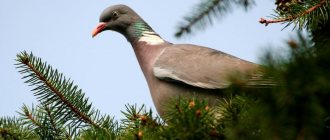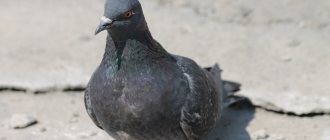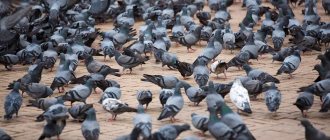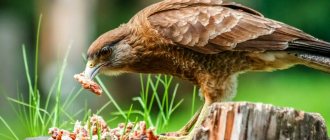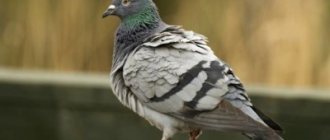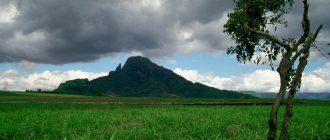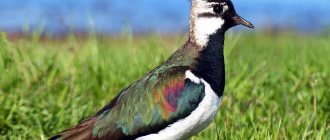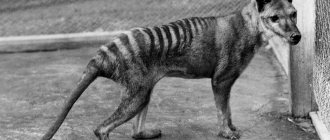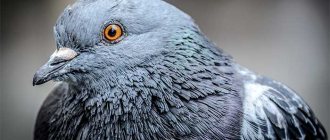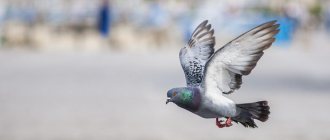- Wild animals
- >>
- Birds
The passenger pigeon is an eternal reproach to humanity. An example of the fact that any species can be destroyed, no matter how numerous it may be. Now more is known about the wanderers than during their lifetime, but this information is incomplete and is often based on the study of stuffed animals, bones, records and sketches of eyewitnesses. Much of the information comes from genetic research.
Origin of the species and description
Photo: Passenger Pigeon
The passenger pigeon (Ectopistes migratorius) is the only representative of the monotypic genus Ectopistes from the family Pigeon. The Latin name given by Linnaeus in 1758 reflects its nature and translated means “migrating wanderer” or “nomad”.
This is an endemic species of North America. Genetic studies have shown that its living closest relatives from the genus Patagioenas are found only in the New World. More distant and species-diverse relatives of true pigeons and cuckoo doves inhabit southeast Asia.
Video: Passenger Pigeon
According to one group of researchers, it was from here that the ancestors of the passenger pigeon once set off in search of new lands, either through the Bering land or directly through the Pacific Ocean. Fossil remains indicate that approximately 100,000 years ago the species already lived in different states of the North American continent.
According to other scientists, family ties with East Asian pigeons turn out to be more distant. The ancestors of New World pigeons must be sought in the Neotropics, that is, the biogeographic region uniting South and Central America and the adjacent islands. However, both of them carried out genetic analyzes on museum material and the results obtained cannot be considered particularly accurate.
Woolly Mammoth
They became extinct approximately 10 thousand years ago.
Scientists are a serious and pragmatic people. Do not think that they choose candidates for cloning from among their favorites. No, the researchers are analyzing how the resurrected species could benefit the current ecosystem. If the animal contributes to its stabilization and improvement, he is given a chance to return from oblivion.
Take, for example, the woolly mammoth (Mammuthus primigenius) and its neighbors, who lived 2 million - 10 thousand years ago. With the extinction of these giants, as well as woolly rhinoceroses, ancient bison and roe deer, the richest flowering mammoth steppes, on which other large herbivores fed: wild horses, musk oxen, and moose, also disappeared. Now in the north of our country, where all these animals lived, there is bare tundra. The last ice age destroyed not only the megafauna, but also the flora.
It seems that the idea of resurrecting mammoths has been in the air since the moment it was determined that they were extinct. But recently the idea began to come true. In 2008, a group of Russian geneticists deciphered the sequence of mitochondrial DNA (mitochondria are an essential component of every animal and plant cell, along with the cell nucleus, Golgi apparatus, ribosome, lysosome, etc.), isolated from the fossil remains of a woolly mammoth. And in 2011, an international team led by Webb Miller and Stefan Schuster from the University of Pennsylvania (USA) recovered 70% of the mammoth's DNA. In 2015, Harvard professor George Church successfully transplanted some mammoth genes into the DNA of an African elephant. Currently, a large collaboration of scientists from Russia, the USA, South Korea and Japan is working on cloning the woolly mammoth. There are no positive results yet, but observing the perseverance of the researchers, one can at least hope for success.
Even greater hope for the resurrection of the mammoth is given by the fact that in Yakutia for the last 20 years they have been preparing a home for this beast - restoring the plant diversity of the mammoth steppes. The project called “Pleistocene Park” was launched in 1997 by Russian ecologist, director of the North-Eastern Scientific Station of the Russian Academy of Sciences Sergei Zimov.
From time to time, researchers discuss the need for the return of another representative of the Pleistocene megafauna - the woolly rhinoceros (Coelodonta antiquitatis). But no one is seriously engaged in cloning it yet.
Appearance and features
Photo: What a passenger pigeon looks like
The wanderer was adapted for long, high-speed flights, as evidenced by everything in the structure of his body: a small head, streamlined contours of the figure, long sharp wings and a tail, which makes up more than half of the body. Two particularly long feathers in the center of the tail emphasize the elongated shape of this bird, designed for flight.
The species is characterized by sexual dimorphism. The length of an adult male was about 40 cm, weight up to 340 g. The male’s wing was 196–215 mm long, the tail was 175–210 mm. The coloring can now be judged from dusty effigies and drawings made from them or from memory. Only one artist is reliably known to have posed for live pigeons - Charles Knight.
The smooth gray feathers of the head turned iridescent on the neck, like those of our sisar. Depending on the lighting, they shimmered purple, bronze, and golden-green. The bluish-gray coloring with an olive tint on the back smoothly flowed onto the secondary coverts. Some coverts ended in a dark spot, giving the wings a variegated appearance.
The flight feathers of the first order were contrastingly dark and the two central tail feathers had the same color. The remaining tail feathers were white and gradually shortened from the center to its edges. Judging by the images, the tail of this dove would be more suitable for a bird of paradise. The apricot color of the throat and chest, gradually fading, turned into white on the belly and undertail. A black beak, crimson-red eyes and bright red paws completed the picture.
The female was slightly smaller, no more than 40 cm, and looked less provocative. Mainly due to the brownish-gray color of the breast and throat. It was also distinguished by more variegated wings, flight feathers with a reddish border on the outside, a relatively short tail, and a bluish (rather than red) ring around the eye. Juveniles, in general, resembled adult females, differing in the complete absence of iridescence on the neck, dark brownish coloration of the head and chest. Sex differences appeared in the second year of life.
Links
- I. I. Akimushkin
. [www.4ygeca.com/str_golub.html The Tragedy of the Passenger Pigeon] // “Traces of Unseen Beasts”, M.: Geographgiz, 1961. - [vip.km.ru/megabook/animal/encyclop.asp?topicnumber=3431¶m=&rubr=152777 Encyclopedia VIP.KM.RU]
- [unknownpoles.com/pereletnyi_golub.html Passenger pigeon] on the website [unknownpoles.com Extinct animals]
- [birdlife.org.ua/ppigeon.htm Requiem for a Passenger Pigeon]
| p • o • p Recently extinct birds |
| Ratites Moa · Black emu · Epiornis · Syrian ostrich · Greater moa · Southern moa · Tasmanian emu (English)Russian · Forest Lesser Moa · Kangaroo Island Emu (English)Russian. Penguin-like Chatham penguin Grebes Pygmy grebe · Andean grebe · Atitlan grebe Petrel-like Guadalupe storm petrel · Jamaican petrel · Greater St. Helens petrel · Olson's petrel · Lesser St. Helens petrel Pelicaniformes Steller's cormorant Storks Threskiornis solitarius · New Zealand Little Bittern · Bermuda Night Heron · Bonin Nanjing Night Heron · Mauritius Night Heron · Reunion Night Heron · Rodrigues' Night Heron · Ascension Night Heron · Dubois's Heron Anseriformes Pink-headed duck · Labrador eider · Amsterdam duck · Chatham duck · Washington gadwall · Mariana mallard · Mauritius duck · Mauritius shelduck · New Zealand lobed duck · New Zealand black swan · Reunion shelduck · Finch's maned duck · Scarlet's pink-eared duck · Auckland merganser · Yellow-billed merganser Naisfur's pintail · Reunion Ground Goose · Moorish Duck Falconiformes Guadalupe caracara · Reunion kestrel Accipitridae Accipiter francesiae pusillus · Haast's Eagle · Ail Harrier Galliformes Heather grouse · Two-banded argus · Himalayan partridge · New Zealand quail Crane-like White Sultan · New Caledonian Wood Rail · Debois' Rail · Ascension Rail · Tahitian Red-billed Rail · Laysan Crake · Rufous Mauritius Rail · Legata's Rail · Mascarene Coot · St. Saint's Rail · Antillean Cave Crake · Winged Crake · Chatham Rail · Dieffenbach's Rail · Hawaii Crake · Large Chatham Rail · Red-necked Wood Rail · Reunion Cuvier's Rail · Reunion Sultan · Wake Rail · North Island Sultan · St. Helen's Darter · Tristan Moorhen · Cusaien Crake · San Benedicto Island Rock Long-billed Wren Charadriiformes Great Auk · Canary Sandpiper · Forbes' Auckland Sandpiper · North Island Auckland Sandpiper · South Island Auckland Sandpiper · St. Helen's Hoopoe · Tahitian Sandpiper · White-winged Sandpiper Parrots Yellow-green Jamaican macaw Red Jamaican macaw Virginia macaw Guadalupe aratinga Guadalupe macaw Yellow-green Dominican macaw Carolina parakeet Cuban macaw Paradise flat-tailed parrot Rodrigues necklace Parrot Rodrigues parrot Seychelles ring-necked parakeet Tahitian kakariki Slender-billed Nestor · Purple Amazon · Macquarie Jumping Parrot · Mascarene Parrot · Martinique Amazon · Martinique Macaw · Mauritius Chick-toothed Parrot · Lordhouse Red-fronted Jumping Parakeet · Red-tailed Blue-and-Yellow Macaw · Reunion Ringed Parrot · Ulyetan Kacariki · Mauritius Gray Parrot · Puerto Rican A rating · New Caledonian loris Pigeonidae Passenger Pigeon · Silver-banded Pigeon · Tufted Thick-billed Pigeon · Mauritius Dodo · Rodrigues Dodo · Bonin Pigeon · Green-maned Pigeon · Lordhouse White-throated Pigeon · Madeira Wood Pigeon · Mauritius Blue Pigeon · Red-capped Pigeon · Norfolk Ground Pigeon · Reunion Rose Pigeon · Rodrigues Pigeon · Tannan ground pigeon · Great-billed chicken pigeon · Dubois pigeon Owls Mascarenotus · Swift-shaped Mangai swift Hummingbirds Turquoise erion · Brace's emerald hummingbird Cuckoo-like Delalande's Madagascar cuckoo · St. Helen's cuckoo · Norfolk cuckoo Woodpeckers American Royal Woodpecker · Cuban Ivory-billed Woodpecker Passeriformes New Zealand Whistlers · Hawaiian Tree Warbler · Bahamas Warbler · Scale-throated Moho · Yellow-eared Moho · Kioeea · Moho-oahu · Noble Moho · Stephen's Bush Wren · New Zealand Bush Wren · Aldabran Warbler · Huia · Munro's Finch Hawaiian Flowerbird · Hawaiian Palm Flowerbird · Orange-breasted Common Flower Finch · Yellow-headed Flower Flower · Buller's Starling · Norfolk Aplonis · Large-billed Flower Flower · Black-billed Mamo Flower · Yellow-throated Mamo Flower · Greater Hawaiian Treecrest · Chatham Bluebell · Oahu Thrush · Chestnut Starling · Bonin Ground Thrush · Mascarene Crested sk thief · Chatham Bowdler · Cyprus Dipper · Daito Island Common Wren · Dark Reed Bunting · Canary Black Oystercatcher · Red-eyed Caiman Thrush · Greater Amakihi · Guam Flycatcher · Hawaiian Akialoa · Kauai Palila · Kauai Akialoa · Great-billed Flowerfinch · Ka Wye Hermit Thrush · Lanai Alauahio · Laysan Firebird · Lordhouse Gray Flightbird · Lordhouse Mountain Thrush · Lordhouse Rock Thrush · Lordhouse Aplonis · Lanai Akialoa · Molokai Flowerbird · Bonin White-eye · Norfolk Mountain Thrush · Oahu Hawaiian Sicklebill · Oahu Hawaiian Treecrest · Faroese Crow · Reunion Foodie · Rodrigues Starling · Rocky San Benedicto Island Wren · Slender-billed Starling · Tasmanian Starling · Cusaien Starling · Chubby Finch · Hawaiian Warbler · Lordhouse Gray Gerygon · Swamp Grackle |
Where did the passenger pigeon live?
Photo: Bird passenger pigeon
During the last stage of the species' existence, the range of the passenger pigeon practically coincided with the area of distribution of broad-leaved forests occupying the central and eastern regions of North America from southern Canada to Mexico. Pigeon flocks were distributed unevenly: they mainly migrated throughout the territory in search of food, and settled stably only for the breeding season.
Nesting areas were limited to the states of Wisconsin, Michigan, New York in the north and Kentucky and Pennsylvania in the south. Occasional wandering flocks were observed along the chain of rocky mountains, but for the most part the western forests were left to the disposal of the wanderers' competitor, the band-tailed pigeons. During cold winters, passenger pigeons could fly as far south as Cuba and Bermuda.
Interesting fact: The coloring of these pigeons is very stable, judging by the stuffed animals. Among hundreds of specimens, a single atypical one was discovered. The female from the Natural History Museum in Tring (England) has a brownish upperparts, white underparts, and white first-order flight feathers. There is a suspicion that the scarecrow was simply in the sun for a long time.
Huge flocks required appropriate territories to accommodate them. Ecological preferences during migrations and nesting were determined by the availability of shelters and food resources. Such conditions provided them with extensive oak and beech forests, and in residential areas - fields with ripened grain crops.
Now you know where the passenger pigeon lived. Let's see what he ate.
In which museums can you see
Stuffed extinct pigeons can be seen today in the following museums:
- Zoological Museum of Moscow State University;
- Darwin Museum of Moscow;
- Zoological Museum of the Russian Academy of Sciences in St. Petersburg.
The body of the last individual was frozen in a block of ice and transferred to the Smithsonian Washington Institution. The stuffed animal was later exhibited at the National Museum of Natural History.
There are approximately 1,500 stuffed passenger pigeons worldwide, including 16 skeletons.
What did the passenger pigeon eat?
Photo: Extinct Passenger Pigeon
The poultry menu depended on the season and was determined by the food that was in abundance.
In spring and summer, the main food was small invertebrates (worms, snails, caterpillars) and soft fruits of forest trees and grasses:
- serviceberry;
- late and Pennsylvania bird cherry;
- red mulberry;
- Canadian derena;
- riverside grapes;
- local blueberry species;
- Western raspberries and blackberries;
- Lakonos.
By autumn, when the nuts and acorns ripened, the pigeons set off on their search. Rich harvests occurred irregularly and in different places, so that from year to year the pigeons combed the forests, changing routes and stopping at abundant sources of food. They either flew as a whole flock, or sent individual birds on reconnaissance, which made daytime flights over the area, moving away to a distance of up to 130, or even 160 km from the overnight site.
Mainly they were eaten:
- acorns of 4 types of oaks, mostly white, which was much more widespread in those days;
- beech nuts;
- the fruits of the scalloped chestnut, which had not yet been destroyed by an epidemic of a fungal disease introduced at the beginning of the twentieth century;
- lionfish of maples and ash trees;
- cultivated grains, buckwheat, corn.
They ate this all winter and fed the chicks in the spring, using what did not have time to germinate. Birds dug up food among fallen leaves and snow, plucked it from trees, and they could swallow acorns whole thanks to their extensible pharynx and the ability to open their beaks wide. The wanderer's crop was distinguished by its exceptional capacity. It was calculated that 28 nuts or 17 acorns could fit in it; the bird consumed up to 100 g of acorns per day. Having quickly swallowed their food, the pigeons sat in the trees and without haste began to digest what they had caught.
INTERESTING INFORMATION. DID YOU KNOW THAT...
- The wandering, or migratory, pigeon is called the same in all languages.
- When settling down for the night, passenger pigeons sat so closely on tree branches that branches up to 60 cm thick broke under their weight.
- According to some sources, the last passenger pigeon was killed in 1899 in Ohio, and a bronze memorial plaque was placed at the site of its death. Other sources claim that this happened in 1900. The last pigeon, named Martha, died on September 1, 1914 at the Cincinnati Zoo.
Features of character and lifestyle
Photo: Passenger Pigeon
Passenger pigeons were nomadic birds. All the time free from incubation and feeding of offspring, they flew from place to place in search of food. With the onset of cold weather, they moved to the south of their range. Individual flocks numbered billions of birds and looked like writhing ribbons up to 500 km long and 1.5 km wide. It seemed to observers that there was no end to them. The flight altitude varied from 1 to 400 m depending on the wind strength. The average speed of an adult pigeon on such flights was about 100 km/h.
In flight, the pigeon made quick and short wing beats, which became more frequent before landing. And if in the air he was agile and easily maneuvered even in a dense forest, then on the ground he walked with clumsy short steps. The presence of the pack could be known from many kilometers away. The birds made loud, sharp, tuneless calls. The situation demanded this - in a huge crowd, everyone tried to out-shout the other. There were almost no fights - in conflict situations, the birds were content to threaten each other with outstretched wings and disperse.
Interesting fact: Recordings of pigeon calls made by American ornithologist Wallis Craig in 1911 have been preserved. The scientist recorded the last representatives of the species living in captivity. Various chirping and grumbling signals served to attract attention, cooing invited mating, and a special melody was performed by the pigeon on the nest.
Wanderers chose large areas for overnight stays. Particularly large flocks could occupy up to 26,000 hectares, while the birds sat in terrible crowds, squeezing each other. The stopping time depended on food supplies, weather, and conditions. The parking locations could change from year to year. The lifespan of free pigeons remains unknown. In captivity they could live for at least 15 years, and the most recent representative of the species, Martha the Dove, lived 29 years.
Habitat
The passenger pigeon was found throughout much of the North American eastern Rocky Mountain region, from the Great Plains to the Atlantic Coast in the east, to southern Canada in the north, and to northern Mississippi in the southern states, which coincide with the bird's primary habitat of eastern broadleaf forests.
Within this range, the pigeon constantly migrated in search of food and shelter.
The species originally bred from eastern and central Southern Canada to eastern Kansas, Oklahoma, Mississippi and Georgia, but the main breeding range was in southern Ontario and the Great Lakes region towards the states in the northern Appalachian Mountains.
Pigeons have been occasionally, but very rarely, seen in the Wild West and even outside the United States and Canada in Mexico, Cuba and Bermuda.
More than 130 remains of passenger pigeons have been discovered in 25 American states and provinces. The age of these finds was about 100,000 years.
Social structure and reproduction
Photo: The Vanished Passenger Pigeon
Wanderers are characterized by communal nesting. From the beginning of March, flocks began to converge on nesting areas. By the end of the month, huge colonies appeared. One of the last, recorded in 1871 in a Wisconsin forest, covered 220,000 hectares, was home to 136 million individuals and was so crowded that there was an average of about 500 nests per tree. But usually colonies were limited to an area of 50 to a thousand hectares. Nesting lasted from one to one and a half months.
The process of courtship between a male and a female precedes mating. It took place in the canopy of branches and included gentle cooing and spreading of the tail and wings, which the male used to trace along the surface. The ritual ended with the female kissing the male, exactly as the sisari do. It remains unknown how many times they hatched chicks per season. Most likely, only one. Over the course of several days, the newlyweds built a nest from branches in the form of a shallow bowl about 15 cm in diameter. There was usually one egg, white, 40 x 34 mm. Both parents hatched it in turn, the chick hatched after 12 - 14 days.
The chick is a typical child of nesting birds; it was born blind and helpless, and initially fed on the crop milk of its parents. After 3–6 days he was switched to adult food, and after 13–15 they stopped feeding him completely. The chick, already fully feathered, gained independence. The whole process took about a month. A year later, if he managed to survive, the youngster would build a nest himself.
Vocalization
The noise made by the flock of passenger pigeons was deafening and could be heard for miles, and the vocalizations seemed loud, harsh and tuneless. It was also described as clucking, chirping, cooing and a series of low notes rather than a full song.
Presumably, the birds made croaking sounds while building a nest, and imitated the ringing of bells during mating. During feeding, when a threat appeared, individual individuals made alarm calls, and the rest of the flock during takeoff
Natural enemies of the passenger pigeon
Photo: Bird passenger pigeon
Pigeons, no matter what species they belong to, always have many enemies. The pigeon is a large, tasty and unprotected bird.
On the ground and in the crowns of trees they were hunted by predators of all sizes and different taxonomies:
- nosy mustelids (American mink, marten, long-tailed weasel;
- raccoon gargle;
- red lynx;
- wolf and American fox;
- black bear;
- puma.
The chicks, which were caught on the nests and during the flight period, were especially vulnerable. Adult birds were chased in the air by eagles, falcons and hawks, and owls got at them at night. They found parasites in passenger pigeons - posthumously, of course. These are a pair of lice species that were thought to have gone extinct along with their host. But then one of them was discovered on another species of pigeon. This is a little comforting.
The most dangerous enemy turned out to be the man to whom the wanderers owed their disappearance. The Indians have long used pigeons for food, but with their primitive hunting methods they could not inflict significant damage on them. With the beginning of the development of the American forest by Europeans, pigeon hunting took on a wide scale. They were killed not only for food, but for feathers and sport hunting, as feed for pigs, and most importantly, for sale. Many hunting methods were developed, but they all boiled down to one thing: “How to catch or kill more.”
For example, up to 3,500 pigeons could fly into special tunnel networks at a time. In order to catch young, particularly tasty birds, nesting sites were destroyed, trees were cut down and burned. In addition, they were simply destroyed as agricultural pests. Deforestation in nesting areas caused particular harm to pigeons.
Interesting facts about the bird
- Other names for wanderer: blue dove, wandering long-tailed dove.
- Continuous flight could reach 14 hours.
- Trees broke under the weight of the large flock, and a layer of droppings 30 cm high was observed in the parking areas.
- If a tree on which the birds were sitting was struck by lightning, up to 100 birds could immediately die.
- Birds helped disperse North American oak seeds. After the extinction of the species, almost all the forests of North America changed their appearance. Deciduous trees gave way to conifers, and with them many small organisms and plants disappeared.
- The bird's voice resembled a barely audible quack. She also made sounds familiar to pigeons in the form of cooing. The male sang a special song on the nest and before mating.
- The Indians hunted exclusively for chicks, because their meat was more tender than that of adults.
- During the flight, the flock was capable of completely eclipsing the sky for several hours.
- In the USA, a memorial was erected to the last dove, Martha. Her shelter in Cincinnati has the status of a national historical monument.
Great auk
The last representatives were destroyed in the 1850s
The only flightless bird from the auk family, which includes many modern sea birds: puffins, guillemots, little auks, auklets, etc. The great auk (Pinguinus impennis) lived along the northern waters of the Atlantic Ocean (on the coast of the North-East USA, Canada, Greenland, Iceland , Faroe Islands, Norway). With its structure, sluggishness, and black and white coloring it resembled penguins. Scientists have long argued about their relationship. However, in 2002, when the mitochondrial DNA of the Great Auk was deciphered, it became obvious that this bird came from a completely different family.
During the era of great geographical discoveries, the down and eggs of the great auk were in great demand among Europeans. By the 19th century, the bird population had declined greatly, and stuffed animals had increased significantly in price among collectors, which provoked a new round of violence against auks. Their natural enemies: killer whales and polar bears also helped people exterminate birds. There is a version that the last individuals living near the Canadian island of Newfoundland were found and destroyed by poachers in the 1850s.
Several scientific groups from the USA and Europe are trying to resurrect this animal with the support of the same organization Revive and Restore.
Great auks (John James Audubon's drawing from Birds of America). Photo: wikipedia.org
Bucardo
The species was officially declared extinct in 2000.
The bucardo (Capra pyrenaica pyrenaica) is an extinct subspecies of the Pyrenean ibex. These animals lived in the north of the Iberian Peninsula (Spain). Several factors probably contributed to their disappearance: poaching, environmental degradation, and competition for food with domesticated ungulates.
The last individual, named Celia, died in 2000 in a Spanish national reserve located in the province of Huesca. However, scientists from the Research Center for Agriculture and Technology of Aragon saved Celia's genetic material and in 2009 tried to create a clone of her. The chances of success were great, because geneticists did not have to spend a long and painful time identifying the closest relatives - females of two other subspecies of the Iberian goat were taken as surrogate mothers.
Spanish biologists created 439 embryos and implanted them into the wombs of 57 goats. Pregnancy occurred in seven females, but only one was able to bear a calf. Unfortunately, the baby goat died minutes after birth. After this, work to resurrect the bucardo was suspended indefinitely.
Mauritian dodo, or dodo
Exterminated in the 1680s
The image of this bird, which lived exclusively on the island of Mauritius, is familiar to many from Lewis Carroll’s fairy tale “Alice in Wonderland.” The main character meets a creature named Dodo at the Tear Pool and is surprised by his abstruse speech, confusing and overloaded with terms. In John Tenniel's illustrations for the first edition of the book, Alice's new acquaintance is depicted as a bird with a heavy body, large paws, tiny wings and a powerful beak, widening in the middle, curved and pointed at the very tip. This is exactly how the Mauritian dodo (Raphus cucullatus) is depicted in the sketches of the Dutch colonialists who arrived in Mauritius at the end of the 16th century. Their illustrations and diary entries are the first documentary evidence of the existence of the dodo.
Like passenger pigeons, dodos aroused purely gastronomic interest among settlers, as evidenced by surviving entries in ship logs and diaries. “This bird is so large that we couldn’t eat it all at once; the remaining meat had to be salted,” sailor William van West Replacement either complained or rejoiced.
Dodos were indeed large: the height of some individuals reached a meter, weight - 17 kilograms. These birds were exterminated quickly, because they were easy prey: they had no natural enemies and allowed people to get close. Domestic animals brought by sailors—dogs and pigs—who stirred up dodo nests and feasted on their eggs also contributed to the disappearance. According to modern research, the last individuals of the Mauritian dodo died at the end of the 17th century.
At the beginning of the 2000s, British and American scientists, under the leadership of molecular biologist and geneticist, professor of evolutionary biology Beth Shapiro, began deciphering the dodo genome. The work is being carried out at the University of Oxford; dried dodo heads from the collection of the Oxford Museum of Natural History are used as biomaterial. So far, scientists have only partially restored the bird's DNA and began to compare its genes with the DNA of modern birds - potential relatives of the dodo. This is important, because a species can only be restored by introducing its genes into the egg of a living organism from a common family. There have been no sensational results yet.
Dodo skeleton and model based on modern research (Oxford University Natural History Museum, UK). Photo: wikipedia.org
